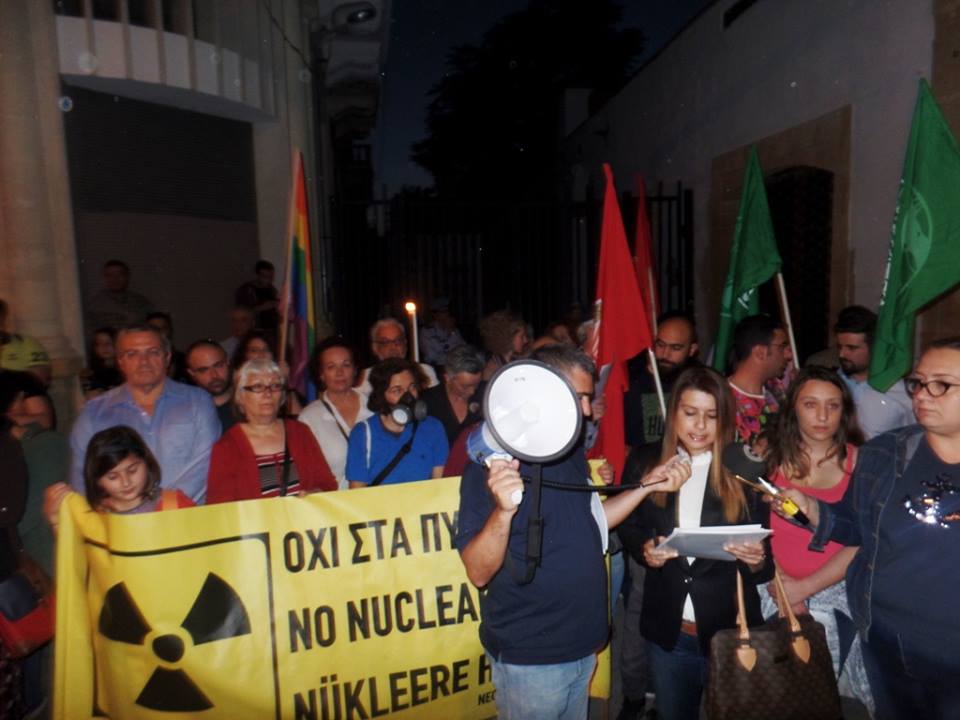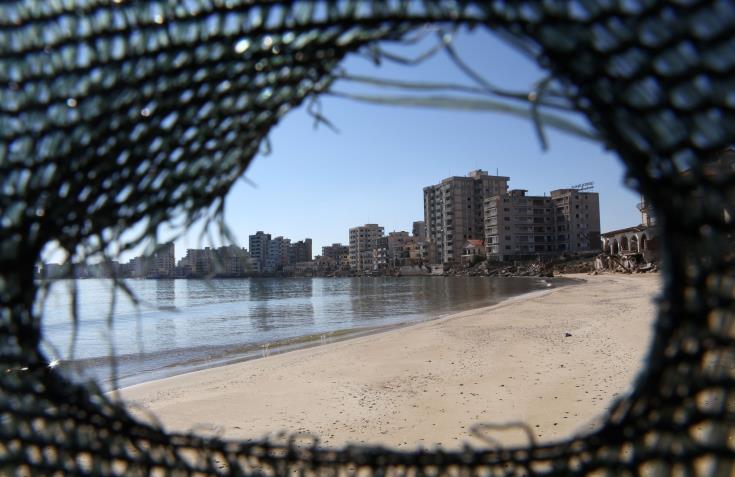
“Nuclear power plants are threatening our future”
Joint Statement on the “Bi-communal action against nuclear power plants”
Ledras Street, Nicosia, 26th of April, 2016
 After the impact of the accident which occurred at the Fukushima Nuclear Power Plant following the earthquake and tsunami in Japan on 11th of March 2011, the world stepped back from nuclear energy, often termed as the supposed “clean energy”. As a result European countries, where nuclear energy is widely used, announced that they will close down nuclear power plants. Furthermore, those countries that wanted to build new plants announced that they would not do so.
After the impact of the accident which occurred at the Fukushima Nuclear Power Plant following the earthquake and tsunami in Japan on 11th of March 2011, the world stepped back from nuclear energy, often termed as the supposed “clean energy”. As a result European countries, where nuclear energy is widely used, announced that they will close down nuclear power plants. Furthermore, those countries that wanted to build new plants announced that they would not do so.
Today, all the countries in the world are trying to get rid of nuclear energy. Canada and America since 1978 and Germany since 1982 have not ordered any new nuclear plants to be built. France has suspended the operation of nuclear power plants since 1997. Brazil has abandoned both her almost completed second nuclear power plant and in addition the third plant on which it has spent 1.1 billion dollars. Italy closed down its nuclear power plants following the result of a referendum held in 1987. Germany closed down the SNR-300 Kalkar and Hanau MOX plants before they began operating in 1991. Spain has closed down some of her nuclear power plants.
According to research done by the Chamber of Environmental Engineers in the Republic of Turkey, Cyprus is one of the areas that will be mostly affected by the negative impacts of the Akkuyu Nuclear Power Plant and also the radiation from a possible accident. During the research, the Chamber has followed the Radioactive Particle Dispersion Modelling (HYSPLIT) Hybrid Single Particle Lagrangian Integrated Trajectory Model http://ready.arl.noaa.gov/HYSPLIT.php , developed by USA-NOAA department,).
Similarly, research carried out by the Cyprus Institute, Department of Energy, Environment and Water Research Centre, shows that Cyprus is in great danger from the Nuclear Power Plants which are planned, under construction and will start operating in the Mediterranean and the Middle East. Due to the prevailing north and west winds, it has been determined that there is a great danger of pollutants being carried in the atmosphere from Europe to the Mediterranean Region.
It is obvious that the radioactive emissions of Akkuyu Nuclear Power Plant in the southern part of Turkey will be mainly affecting Cyprus due to the meteorological circumstances. It is also determined that Mersin and Nicosia will be exposed to almost the same risk.
The primary source of energy of the nuclear power plants is uranium and it is estimated that the world uranium reserves will last for 30-60 years. It is necessary to store the combusted fuel for 250 thousand years far away from the risk of any accident.
Nuclear waste, which has high temperature of up to 70°C, has to be stored in nearby cold water pools. This resting process lasts 5 years and subsequently the intermediate storing process starts. In order to decrease the rate of radiation the cooled radioactive matter is being kept in “intermediate storage” for approximately 30 years, before it is buried under the soil. These storage tanks are constructed of 60cm walls of concrete and steel as they have to be resistant to earthquakes, floods and fire. In the last phase, the waste which has been held in storage for 35 years is buried under the soil. Former old and dried up mines are used for this phase and they are found at a depth of 200-900 metres. In Europe around 12 thousand tons of waste have been buried under the soil.
The diseases caused by the radiation emitted into the environment during the operation phase of the nuclear power plants are alarming. There is an increase in leukaemia rates especially among children, according to research conducted in various countries.
In the brief sixty year history of nuclear power plants in the world, there have been two major catastrophic accidents. One of them was in Chernobyl in 1986 and the other one 25 years later in Fukushima in 2011. According to the International Nuclear Event Scale (INES), apart from these two accidents which were at Level 7, there were 611 incidents which have been recorded by INES between 1987 and June 2013. As can be understood by these numbers, accidents in nuclear power plants occur frequently. Even though the health effects of these accidents cannot be observed in the short term, it can be predicted scientifically and these effects have to be considered as “completely preventable health problems”.
The proof of the consequences on health caused by the radiation emitted to the environment during the normal operation of the nuclear power plants, the fact that nuclear waste cannot be eliminated for hundreds of thousands of years, the risk of accidents or terrorist attacks being carried out during the transportation of nuclear waste and the risk of war or terrorist attacks on nuclear power plants all constitute clear evidence that nuclear energy is threatening our present and future. It is therefore obvious that we need to fight against nuclear energy which is putting both humankind, other living creatures and nature under great danger with the excuse of harvesting energy.
The unilateral decision to build a new nuclear power plant without having the consent of the surrounding countries and ignoring the risk of international consequences as a result of a potential nuclear accident is considered a crime under International Law. An impact assessment of a potential nuclear accident and the risk of dispersion of radioactivity for areas with a high seismic risk, a high natural value and a high population density has to be made imperative.
Even under normal operational conditions of nuclear power plants with no accidents, there are emissions of radionuclides and aerosols dispersing into the air, water and soil. According to research conducted in Lithuania, at the surrounding 32 km diameter of the Ignalina Power Plant, under the normal operating conditions with no accidents, high concentrations of radionuclides have been detected on planktons, grass and some water plants.
It is known that both in the construction of nuclear power plants and during their operation, the marine ecosystem is affected. During the operational phase, the plankton’s structure and reproductive capacity is affected by the increasing temperature of the water being discharged into sea. This affects the fish fauna which is feeding on plankton. It is also known that in the Akkuyu area there are caves of endangered turtles and Monachus Monachus (Mediterranean seal). Without any accidents, the waste of the nuclear power plant will be enough to kill animal and plant species, through the poisoned water and the soil in the area. Apart from the living beings in the sea, people will also be indirectly affected.
Clean and renewable energy sources, like solar and wind power, are increasingly being used throughout the world. Wind and solar energy technologies should be preferred instead of nuclear power as they are cleaner methods of energy production.
The progressive party of the working people (AKEL), New Cyprus Party (YKP), United Cyprus Party (BKP), Cyprus Greens – Citizens Cooperation, Social Democratic Party (TDP), Pancyprian Peace Council, EDON, Young Cyprus Greens (NE.OI), PEO, Dev-iş, KTÖS, KTOEÖS, KTAMS, BES, ÇAĞ-SEN, Turkish Cypriot Doctors Union (KTTB), Chamber of Environmental Engineers, Chamber of Landscape Architects, Green Action, Biologists’ Association, Ecological Movement of Cyprus, Friends of Akamas, Bağımsızlık Yolu, Union of Artists and Writers, HASDER, Baraka, FEMA, Queer Cyprus Association




